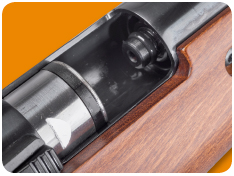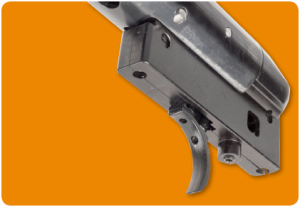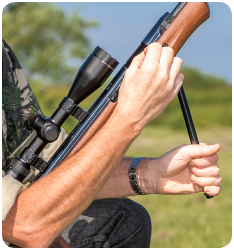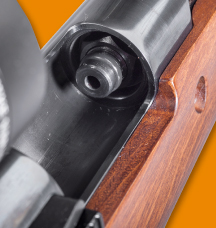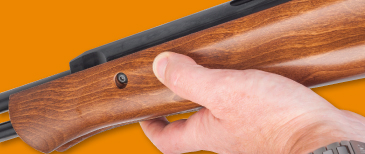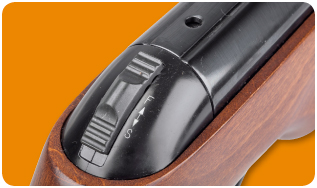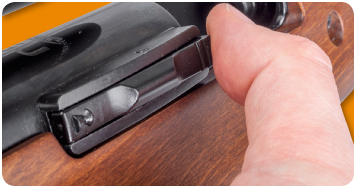Walther LGU: a fixed-barrel air rifle
Colin Fallon puts it to the test

Walther LGU – a serious bit of kit
I’ve already gone on record to say that Walther’s 2012 model of its LGV break-barrel is the finest production air rifle I’ve ever had the pleasure of testing. Incredibly engineered, using some of the most advanced technology ever to grace a mass-produced springer, it’s super-smooth both to cock and shoot – and the breech lock it bears as a legacy to the original LGV model also ensures it’s super-accurate to boot. So why on earth would you ever want a fixed-barrel version of it, you may wonder? (Read our list of the best air rifle pellets.)
Well, it’s a question I posed to Walther when they demonstrated their new Walther LGU – another famous model name from the past – to me in Germany earlier in the year. Here’s their answer: “We don’t need one. We cannot surpass the LGV’s accuracy. But many airgunners think a fixed barrel air rifle is more accurate than a break-barrel one. It was true… until the LGV. So we made the Walther LGU.”
So there you have it. I have an LGU on test for no reason other than because there’s a perceived need for it in shooter land!
A good deal of presence
All joking aside, the new LGU is a serious bit of kit. While the flagship model of the LGV commands a retail price in excess of £500 – and is slow to sell because of it – a beech-stocked LGU will set you back just £349.95. Against like-for-like underlever models from Air Arms (TX200 – £406) or Weihrauch’s HW77K (£393) and HW97K (£402), the LGU is sure to turn a few heads.
Out of its box (which also is quite impressive), the LGU announces itself with a good deal of presence. It’s a big rifle, weighing a whopping 4.4kg – and you’ve got to add sights to that. Weight distribution is well forward, but my Hawke Varmint 2.5-10×44 SF brought the balance back enough to ‘neutralise’ its mass. Nevertheless, this is a rifle that’ll need strong muscle power to shoot well from a standing stance.
The LGU’s weight actually contributes to what is a pretty ‘dead’ firing cycle for a springer. Internally, the LGU is equipped with the same Silent Spring Technology (SST) and Vibration Reduction System (VRS) that was first unveiled in the LGV back in 2012.
It’s slightly modified to suit the different action configuration of the LGU’s fixed-barrel, underlever design, but the piston is still free to rotate around its axis so that no ‘twist’ is felt during the firing cycle as the spring unleashes its coils.
There’s comprehensive use of modern synthetics, too, with both the piston skirt and outer circumference of the inner compression chamber running on Delrin rings. This makes the cocking action most pleasant, with none of the graunching sounds often associated with new springers – and the firing cycle is also ultra-smooth and quiet as a result.
The sprung plate that the LGV’s cocking linkage ran against has disappeared from the LGU, which incorporates a huge interpretation of the ‘slipper’ – the mechanism which engages with the compression cylinder and piston during the cocking process. From what I could see, this slipper is kept in place by a channel milled internally into the stock. There was evidence that Walther had applied grease to keep things running smoothly, and although it didn’t ‘dry out’ during my test period, it may be an area to keep an eye on. Wood, in my opinion, probably doesn’t offer the best of bearing surfaces, however minimal the load!
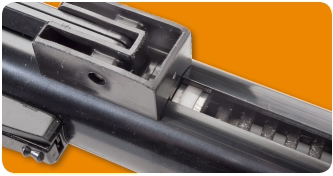
The ‘slipper’ is kept in place by a channel milled internally into the stock. Note also the piston’s Delrin runner
As with the LGV, shooting the LGU is nothing but a pleasure. There’s some semblance of a kick, but those hi-tech internals and the weight make it anything but jumpy. A quick, gentle slap in your shoulder is all you feel and while I definitely shot at my best from ‘supported’ positions, I also noticed that this is one of those rare springers where your zero doesn’t shift according to the stance you’re adopting.
The smooth firing cycle will, I’m sure, be a prime reason for this, but I should also point out that the barrel time of the LGU is very quick – and thus forgiving – too. The Walther-made barrel measures just 285mm, and the muzzle finishes some 100mm short of the end of the integral muzzle brake that incorporates the underlever’s securing ball-catch assembly.
I say ‘brake’ because there are no sound-suppressing baffles inside; it’s just a void. All the same, it does stifle the muzzle crack usually associated with such short barrels – and by unscrewing a 3mm hex bolt underneath, you can remove the brake’s end cap and replace it with an optional, 1/2in UNF threaded silencer adapter. For me, it’s not necessary and may even make the rifle look untowardly long.
The underlever is one of two areas I cannot help but be critical about – and I’ve already let Walther have my views. Operationally, the ball-catch assembly is fine, holding the underlever nicely in place and without any play or vibration during the firing cycle.
But I reckon the Walther technician who was tasked to design the underlever was given the job on a Friday afternoon! To stop any ‘over-travel’ when snapping it shut, we get two of the ugliest rubber O-rings ever to grace an air rifle. Yes they act as buffers well enough… but what a cop-out! What’s worse, you can’t remove them as they’re seated in grooves. A hidden rubber grommet or something similar would have been so much more aesthetic – the LGU is, though beefy, still a very elegant looking gun after all.
And I think the way the underlever is married to the cocking linkage is a little suspect, too. It’s simply triple-riveted to two sheets of a stamped metal arm, and my sample rifle started showing signs of lateral play very early on into the test period. I don’t think it’s a weak link, but considering the engineering elsewhere on the LGU, it’s certainly under par.
The trigger, on the other hand, is well above par – plus, at Armex’s insistence, UK-bound guns get the metal blade upgrade. A one-piece unit to rival the best of the competition, it can be set for first-stage travel and pull weight, and its slip-point is as crisp as you like; I loved the way the test rifle’s was set up by the factory. Protected by a metal guard, the blade is curved, broad and flat-faced, and positioned perfectly in relation to the quite steeply raked pistol grip.
The grip itself is laser-chequered, carrying the Walther logo – though the usual ‘m’ logo that signifies it’s been made by Italian stockmaker, Minelli is absent. It’s quite chunky and long enough for the biggest of paws – plus you can shoot the LGU from the right or left shoulder as the stock has been made ambidextrous courtesy of a twin-sided cheekpiece.
While I applaud the move – and the fact that the cheek’s high enough for the mandatory scope use – I’ve got another issue. For a rifle to be truly ambidextrous, you really need more than just a versatile stock; the action must suit right- and left-handers, too.
Not so on the LGU, although I will say at this point that Walther disagreed with my moan on this one. You see, when the rifle’s been cocked, you’re pretty much forced to load with your right hand as the breech loading cutaway in the receiver is to the right. Even with a normal length scope on board, a right-hander can’t ‘see’ the loading bay in order to guide a pellet into the rifling – and if you’re a left-handed loader (like me), being forced to use your ‘other’ hand means you’ll be forever dropping pellets into the bay!
Weihrauch’s HW77 and HW97 actions are truly ambidextrous by milling the cutaway across the top of the receiver, making it dead easy to load with either hand. I hope that, going forward, Walther see it makes sense to do the same on their underlever.
I’ve got no gripe with the engineering of the breech itself, however. Its lead-in has a decent chamfer and, combined with the choke at the other end, I didn’t have any accuracy issues with quality pellet brands. JSB-made Rangemaster Sovereign and Air Arms Diabolo Field were the most accurate at distances over 35 yards – but out to 25 yards, the LGU spat pellet-on-pellet groups with pretty much whatever diet it was fed.
For the record, my gun absolutely loved H&Ns, with the lightweight Econ flat-heads putting in some scarily tight groups at the 10.9ft/lb mark, along with the Field Target roundhead. The latter, however, was a little tight in the breech and suffered reduced power (9.5ft/lb) because of it – though, surprisingly, heavyweight Baracuda Hunter still registered a 10.5ft/lb power output with field-acceptable accuracy.
As the chart above shows, shot-to-shot consistency was also rather impressive, a function I put down to the hi-tech action and the fact that the breech is sealed by not one, but two O-rings. I certainly predict a healthy career for the LGU on outdoor competition circuit. Walther’s old ‘Universal’ was a dominant force in the world of 10-metre indoor match shooting, and I think the 2014 ‘U’ model will be as equally acclaimed when it’s pushed to 50 yards and beyond by silhouette shooters.
Indeed, while the LGU will bring home the bacon in the field, it’s against metal where I see it making a big name for itself. Its weight distribution is perfect for the over-the-arm field target style hold; if I shoot my rifle like this, I could steer it to print 30mm clusters out to 50 yards in the right conditions. For any springer, not least a production one, that’s seriously impressive.
Actually, the LGU very much reminded me of my old FT rifle of the 1980s – except the LGU was doing it ‘bog-standard’ and I hadn’t had to take out a small mortgage for a load of bespoke engineering work by Airmasters!
Finish-wise – and turning a blind eye to those hideous O-rings on the underlever – the Walther matches the same, impeccable standards of its LGV stablemate. The metalwork has been polished to a mirror finish, and the blueing applied to the steel parts is of a standard that wouldn’t be out of place on the finest of English shotguns.
The beech woodwork is decent, too. The grain pattern on my sample was particularly ‘swirly’, stained to a chestnut brown with a semi-matt lacquer on top. Though the extended forestock lacks chequering, there’s enough hint of a side-scallop to aid grip wherever you wish to hold it – and a Schnabel tip brings things to a happy ending at the front. Meanwhile, a ventilated recoil pad also does so at the rear. There’s really nothing not to like about it.
On the safety front, Walther has equipped the LGU with a rear-end slider catch that automatically engages when the underlever’s drawn back. Nicely located, it can be pushed off and on at will with the thumb of your trigger hand and is silent in use. There’s also an anti-beartrap incorporated into the sliding, inner compression chamber assembly to protect your digits while loading. Cheekily, Walther’s is very similar to the Safe-Lok system Air Arms uses on its TX200 – you have to press it down with your right hand while closing the underlever with your other; ergo you cannot have a hand left ‘in‘ the loading bay.
Despite my little moans, I’m still as ‘wowed’ with the new Walther LGU as I was with the LGV back in 2012. It’s a stunning rifle in both looks and performance, and pretty much gives you a pro-tuned springer right off the bat. At £350, it’s going to prove formidable competition to Air Arms’ TX200 and Weihrauch’s HWs 77K and 97K… and, of course, its older sibling, the LGV break-barrel!
This article was originally published in 2014 and has been updated.

